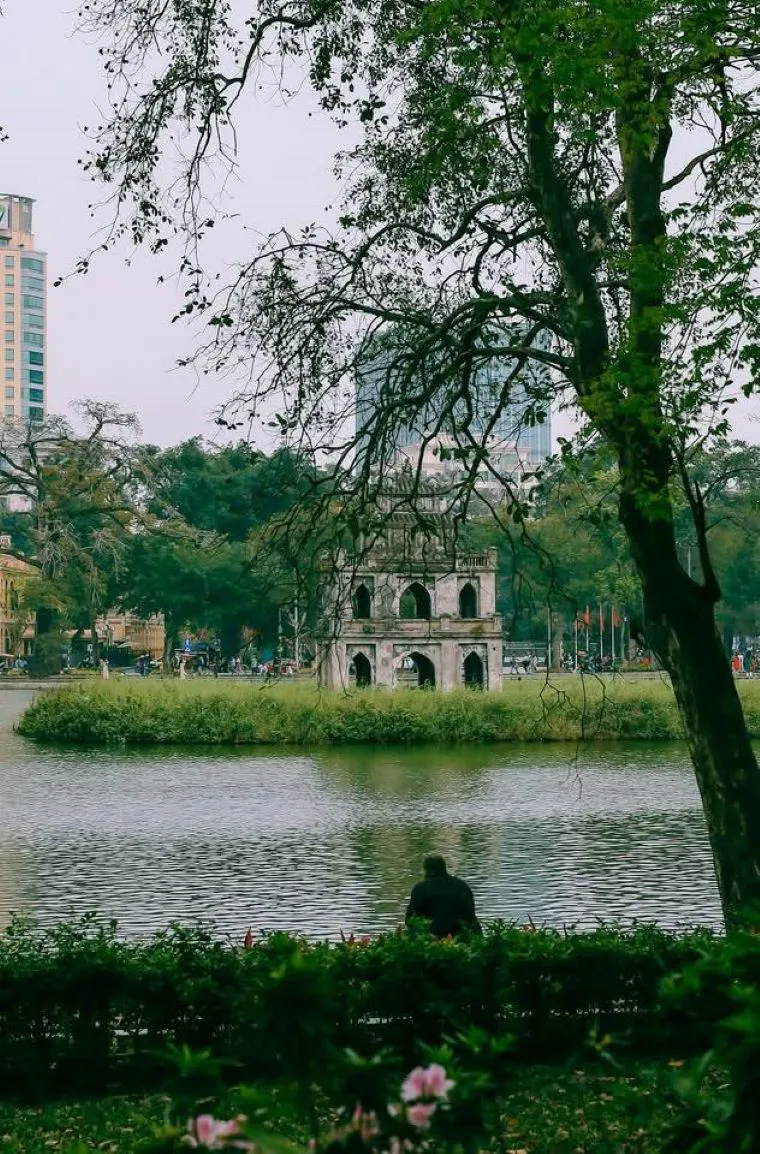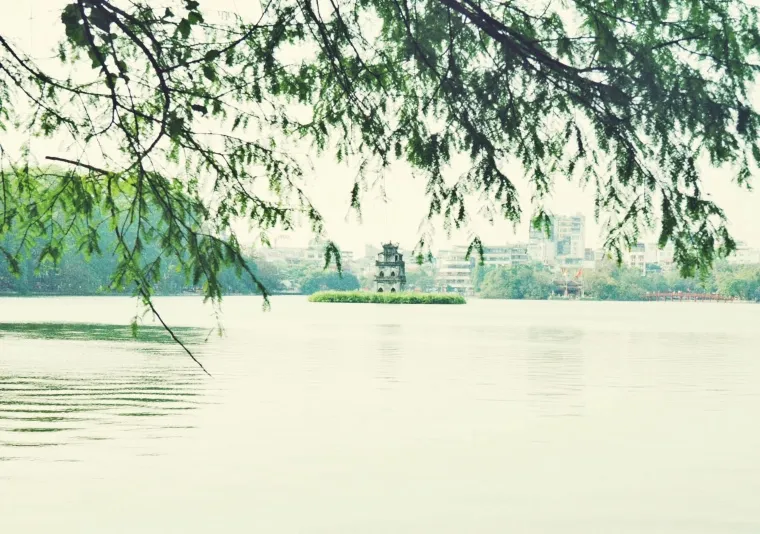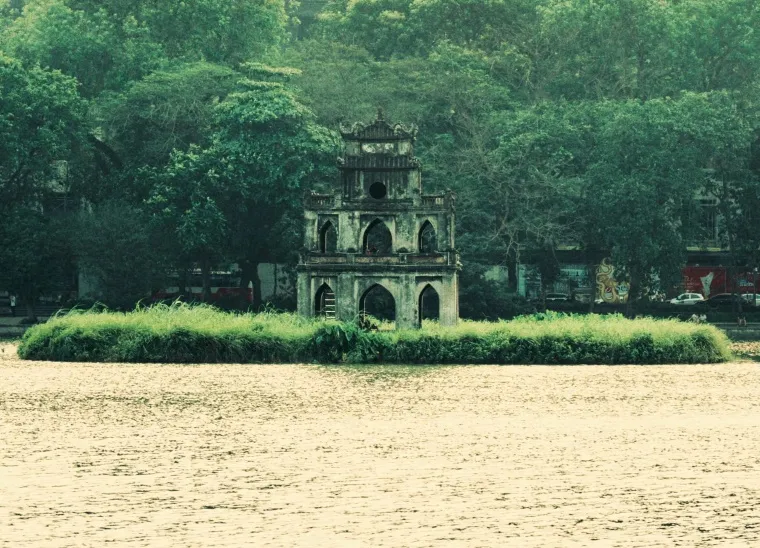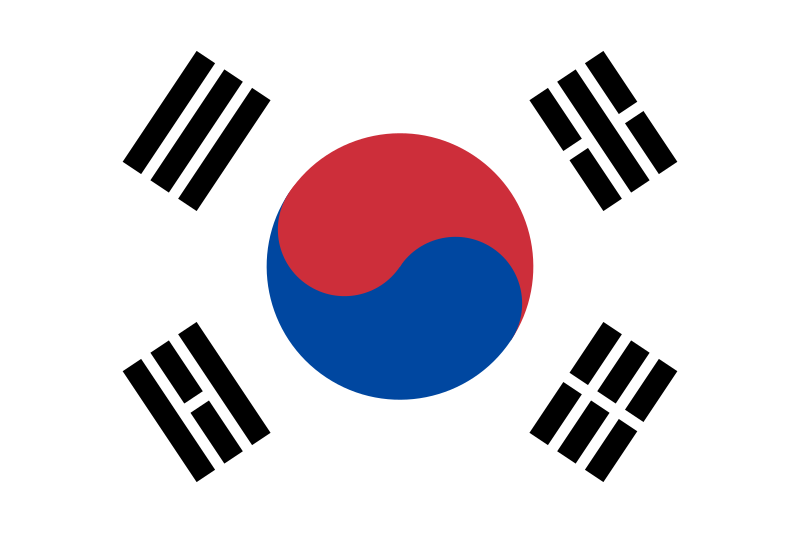After a relaxing photography session, head to Trang Tien Ice Cream, just a short stroll away, to indulge in a refreshing treat that perfectly complements the serene atmosphere of the area.
Turtle Tower: The Immortal Heart of Hanoi's Cultural Heritage
Standing gracefully in the middle of Hanoi's iconic Hoan Kiem Lake, Turtle Tower (Tháp Rùa) has become an undeniable symbol of Vietnam's capital city. This small yet striking architectural marvel carries with it centuries of legends, historical transformations, and cultural significance. For visitors to Hanoi, the tower represents not just a photogenic landmark, but a gateway to understanding the rich tapestry of Vietnamese heritage, resilience, and identity.
1. The Mystical Legend of Hoan Kiem Lake
To truly appreciate Turtle Tower, one must first understand the legendary tale that gave Hoan Kiem Lake ("Lake of the Returned Sword") its name and spiritual significance.
In the 15th century, during Vietnam's struggle against Chinese Ming Dynasty invaders, a humble fisherman named Le Than discovered a magical sword blade in his fishing net. This blade eventually found its way to Le Loi, a resistance leader fighting against the occupation. When Le Loi found the sword's hilt in a banyan tree, the two pieces miraculously united to form Thuan Thien ("Heaven's Will"), a powerful weapon that granted Le Loi extraordinary strength and leadership abilities.

Turtle Tower stands as a symbol of Hanoi, gracefully located on Hoan Kiem Lake. - Facebook Nguyễn Khánh Huyền
With this divine sword, Le Loi led a successful decade-long rebellion, eventually defeating the Ming forces in 1428 and becoming Emperor, founding the Later Le Dynasty. Shortly after his victory, while boating on what was then called Luc Thuy (Green Water) Lake, a giant golden turtle emerged from the waters. Recognizing the turtle as a divine messenger, Emperor Le Loi returned the sword to the creature, who took it in its mouth and disappeared beneath the surface, returning the magical weapon to its rightful owner—the Dragon King.
To commemorate this mystical event, the lake was renamed Hoan Kiem, literally meaning "Lake of the Returned Sword." This legend remains deeply embedded in Vietnamese cultural identity, symbolizing both the country's historical struggle for independence and the wisdom of returning to peace after achieving victory.
2. A Unique Architectural Fusion
Turtle Tower's architecture represents a fascinating blend of Eastern and Western influences, creating a distinctive appearance unlike any other structure.
2.1. Analyzing the Architectural Style
The architecture of Turtle Tower combines French Gothic elements with traditional Vietnamese design features:
-
Gothic Arches: The entrances and windows on the lower floors (1st and 2nd) feature pointed arches, characteristic of French Gothic architecture.
-
Traditional Curved Roof: The tower's roof bears strong influences of ancient Vietnamese architecture with multiple layers of curved hip roofs. This section often includes decorative details such as curved dao heads and dragon moon motifs.
-
Rectangular Structure: The rectangular floor plan of the tower can also be seen as a Western influence.
This architectural fusion physically embodies the cultural encounter and power dynamics of the colonial period, combining architectural forms of the rulers and the ruled into a unique visual statement.
![]()
The iconic Turtle Tower is a beautiful sight, especially during the early morning mist. - Facebook Ha Vu
2.2. Structural Details
-
Location: The tower is built on a natural mound (Turtle Mound) covering approximately 350m² in the middle of Hoan Kiem Lake.
-
Shape and Number of Floors: The tower has a rectangular floor plan with floors that gradually decrease in size upward. Most English-language sources describe the tower as having three main stories, while many Vietnamese sources detail four floors, including the belvedere at the top.
-
Height: The total height of the tower, from the base of Turtle Mound to the top, is consistently reported as 8.8 meters.
-
Floor Dimensions (estimated, with slight variations between sources):
-
1st Floor (Base): Approximately 6.28m long and 4.54m wide, built on a 0.8m high foundation. The long sides (East/West) have 3 arched doors each, the short sides (North/South) have 2 arched doors each, totaling 10 exterior doors.
-
2nd Floor: Smaller than the 1st floor, approximately 4.8m long and 3.64m wide, with a similar door arrangement but smaller in size.
-
3rd Floor: Even smaller, approximately 2.97m long and 1.9m wide, with only one circular window/door on the East side, about 0.68m in diameter.
-
4th Floor (Top/Belvedere): Described as a square belvedere, each side 2m long.
-
-
Inscriptions: The Chinese characters "Quy Son Thap" (塔山龜 - Turtle Mountain Tower) are inscribed above the circular door on the 3rd floor, East side.
-
Other Features: Balustrades surround the upper floors. Some sources mention a five-pointed star at the very top.
2.3. Architectural Assessment
The visual appeal and harmonious integration of Turtle Tower with the landscape of Hoan Kiem Lake are undeniable. It creates a beautiful, ancient, and sacred focal point in the middle of the lake, becoming even more enchanting and mystical when illuminated at night. Its prime location and reflection on the lake's surface have made Turtle Tower a photographic icon and artistic inspiration.
However, alongside admiration for its overall beauty and symbolic meaning, the architecture of Turtle Tower has also received mixed reviews from professionals. Some assessments suggest that the style combination is somewhat forced, lacking sophistication, or not adhering to clear architectural standards.
Despite these potential shortcomings in terms of pure architectural value, Turtle Tower's visual success lies in its harmonious overall composition with the landscape and the symbolic weight it has accumulated over time. This demonstrates that the cultural value of a structure sometimes transcends purely formal architectural assessments.
3. Cultural Significance and Symbolism
3.1. A Symbol of Hanoi and Vietnam
Turtle Tower has transcended its role as a mere architectural structure to become one of the most recognizable and iconic symbols, not only of Hanoi but sometimes representing Vietnam as a whole. It is considered the "soul" and "heart" of the capital. The symbolic weight of Turtle Tower can be compared to other national symbols around the world, such as how the Statue of Liberty represents freedom and democracy in the United States.
3.2. Embodiment of History, Resilience, and Peace
Linked to the legend of Le Loi returning the sword, Turtle Tower has become a symbol of independence, sovereignty, patriotism, strength, and the resilient spirit of the Vietnamese people in their struggle against foreign invasion. The image of the Golden Turtle receiving the sword back also symbolizes peace and prosperity after war.
The tower stands as a tangible connection to Hanoi's thousand-year history and the glorious past of the nation. Through the turtle imagery, it also carries meanings of longevity, wisdom, and good fortune in Vietnamese culture.

This historical tower is named after the legendary Golden Turtle, a central figure in Vietnamese folklore. - Facebook Ha Vu
3.3. Inspiration in Arts and Culture
The beauty and symbolic significance of Turtle Tower have become an endless source of inspiration for Vietnamese art forms, from literature, poetry, and painting to music and photography. The image of Turtle Tower appears abundantly in artistic works, reflecting the beauty, soul, and history of Hanoi.
It has also entered folklore, even featuring in water puppet shows, helping to preserve and spread the legends surrounding Hoan Kiem Lake. Moreover, Turtle Tower serves as a familiar backdrop for everyday life and cultural activities taking place around the lake. This continuous and diverse presence in artistic and cultural life has firmly established Turtle Tower's iconic status.
4. Visiting Turtle Tower: A Practical Guide
4.1. Viewing the Tower: Accessibility and Experience
An important note for visitors is that you cannot directly visit Turtle Tower. The tower stands isolated on the islet in the middle of the lake and can only be admired from the shore. This distance actually contributes to the mystery and allure of the structure.
The main experience is walking around Hoan Kiem Lake, enjoying the fresh, peaceful atmosphere, and observing Turtle Tower emerging between the water and greenery. The area around the lake is always bustling with local activities. Especially on weekend evenings (Friday, Saturday, Sunday), the roads around the lake become a pedestrian street, creating a vibrant community cultural space with artistic performances and traditional games.
4.2. Best Viewing Spots Around Hoan Kiem Lake
Turtle Tower can be seen from most positions around the lake. However, some locations are considered to have the best and most favorable viewing angles:
-
North Shore: The area near the entrance to Ngoc Son Temple and The Huc Bridge. From here, you can capture photos of Turtle Tower along with the distinctive red bridge.
-
East and West Shores: Along Le Thai To and Dinh Tien Hoang streets.
-
South Shore: The area near Dong Kinh Nghia Thuc Square.
-
From Ngoc Son Temple: Even from within the temple compound, you can view Turtle Tower from a different angle.
Hoan Kiem Lake is an ideal location for photography. Visitors can get creative with different shooting angles: capturing the tower's reflection on the calm water surface, framing the tower through lakeside tree branches, or capturing moments of Turtle Tower amid the vibrant life around the lake.

Turtle Tower, with its elegant design, adds a charming touch to the picturesque Hoan Kiem Lake. - Facebook Ha Vu
4.3. Cafes and Rooftops with Great Views
After savoring a warm bowl of Bun Thang, one of Hanoi's most delicate traditional dishes, or enjoying a flavorful pho Thin in Hanoi, there's nothing better than settling into a cozy rooftop to take in the city’s charm from above. Some recommended spots include: Some recommended spots include:
-
Avalon Cafe Lounge: At the corner of Cau Go and Dinh Tien Hoang streets, with views of Turtle Tower, The Huc Bridge, and Ngoc Son Temple.
-
L'etage Cafe: On Hang Khay Street, with a balcony overlooking the lake, Turtle Tower, and Ngoc Son Temple.
-
Thuy Ta Cafe: Located right at the lake's edge, with an outdoor space directly facing Turtle Tower.
-
Highlands Coffee (Shark Jaw Building): On the 3rd floor of the building at the corner of Dinh Tien Hoang and Hang Gai, with panoramic views of Hoan Kiem Lake.
-
The Note Coffee: On Luong Van Can Street, with a small balcony overlooking the lake.
-
Hanoi Time Cafe: On Dinh Tien Hoang Street, with a balcony overlooking the lake.
-
City View Cafe (Shark Jaw Building): On the 5th floor, in the same building as Highlands Coffee, with beautiful views of the lake and Old Quarter.
-
Blue Eyes Sky Bar: On the rooftop of Shining Central Hotel (Lo Su Street), with 360-degree views of Hoan Kiem Lake, Ngoc Son Temple, and Turtle Tower.
4.4. Best Times to Visit and Photograph
Turtle Tower is beautiful at any time of day, and each season has its own charm. However, some times are considered more ideal:
-
Early Morning (Dawn): Soft light, the lake surface is usually calm creating beautiful reflection effects, fresh air, fewer people, and you can observe locals practicing exercise (Tai Chi).
-
Late Afternoon (Sunset/Golden Hour): Warm light, creating a romantic atmosphere.
-
Evening: Turtle Tower and surrounding structures are illuminated, creating a magical, enchanting scenery. This is also when Hoan Kiem Lake becomes peaceful, suitable for walking.
-
Autumn: Hanoi's weather in autumn (approximately September-November) is usually cool, pleasant, and dry, considered the most beautiful season for tourism and sightseeing.
-
Weekends (Evenings): Experience the lively, joyful atmosphere of the pedestrian street around the lake.

The tower’s serene presence in the middle of Hoan Kiem Lake makes it one of Hanoi’s most photographed landmarks. - Facebook Ha Vu
4.5. Exploring Nearby Attractions
The area around Hoan Kiem Lake concentrates many historical, cultural sites and other interesting destinations. Visitors can combine viewing Turtle Tower with exploring these places:
-
Ngoc Son Temple and The Huc Bridge: A famous spiritual building located on Jade Island in the lake, connected to the shore by a distinctive red bridge.
-
Pen Tower and Ink-slab Pavilion: Located at the entrance to Ngoc Son Temple, symbolizing the spirit of study.
-
Ly Thai To Monument and Garden: Commemorating the king who moved the capital to Thang Long (ancient Hanoi).
-
Hanoi Old Quarter and Night Market: Explore traditional craft streets, ancient architecture, and enjoy street food.
-
Ba Kieu Temple: An ancient temple worshipping Mother Goddess Lieu Hanh.
-
Statue of King Le Thai To: Monument to the hero linked to the Hoan Kiem legend.
-
Hoa Phong Tower: Remains of the ancient Bao An Pagoda.
-
Hanoi Opera House: A representative French architectural work (not far from the lake).
Conclusion
From its controversial origins in the colonial context, through its connection to the legendary sword of national hero Le Loi, to becoming an architectural testament to East-West cultural fusion, Turtle Tower has firmly established itself as an irreplaceable symbol and essential part of Hanoi's soul. The journey of Turtle Tower reflects the very transformations and powerful resilience of the city's history and culture.
Today, Turtle Tower quietly reflects in the middle of Hoan Kiem Lake, continuing to be a convergence point of urban landscape and community consciousness. It is not just a beautiful architectural work but also a historical witness, a symbol of national pride, resilience, and aspiration for peace. The contemplative but evocative beauty of Turtle Tower continues to move hearts, connecting past with present, and remains the immortal heart of Hanoi for both locals and visitors.
With a well-planned itinerary, budget-friendly options, and an open mind to meeting new people, your solo journey will be both fulfilling and exciting. Let Joytime be your trusted companion, providing essential travel gear to ensure comfort, safety, and convenience throughout your trip. An incredible solo adventure awaits—pack your bags and explore Hanoi with confidence!
|
Joytime - Your Vietnam Journey's Servant Expert Follow us for travel tips, local insights, and exclusive offers:
|














